
- Neo4j CQL Write Clauses
- Neo4j - Merge Command
- Neo4j - Set Clause
- Neo4j - Delete Clause
- Neo4j - Remove Clause
- Neo4j - Foreach Clause
- Neo4j CQL Read Clause
- Neo4j - Match Clause
- Neo4j - Optional Match Clause
- Neo4j - Where Clause
- Neo4j - Count Function
- Neo4j CQL General Clauses
- Neo4j - Return Clause
- Neo4j - Order By Clause
- Neo4j - Limit Clause
- Neo4j - Skip Clause
- Neo4j - With Clause
- Neo4j - Unwind Clause
- Neo4j CQL Functions
- Neo4j - String Functions
- Neo4j - Aggregation Function
- Neo4j CQL Admin
- Neo4j - Backup & Restore
- Neo4j - Index
- Neo4j - Create Unique Constraint
- Neo4j - Drop Unique
- Neo4j Useful Resources
- Neo4j - Quick Guide
- Neo4j - Useful Resources
- Neo4j - Discussion
Neo4j CQL - UNION
Like SQL, Neo4j CQL has two clauses to combine two different results into one set of results
- UNION
- UNION ALL
UNION Clause
It combines and returns common rows from two set of results into a single set of results. It does not return duplicate rows from two nodes.
Restriction:
Result column types and names from two set of results have to match that means column names should be same and column's data types should be same.
UNION Clause syntax
<MATCH Command1> UNION <MATCH Command2>
Syntax Description
| S.No. | Syntax Element | Description |
|---|---|---|
| 1. | <MATCH Command1> | It is CQL MATCH command one to be used by UNION clause. |
| 2. | <MATCH Command2> | It is CQL MATCH command two to be used by UNION clause. |
| 3. | UNION | It is a Neo4j CQL keyword for UNION clause. |
Note -
If both queries does not return same column names and data types, then it throws an error.
In this chapter, we will take a Banking application nodes : CreditCard and DebitCard to explain UNION clause
CreditCard Node data
Step 1 - Open Neo4j Data Browser
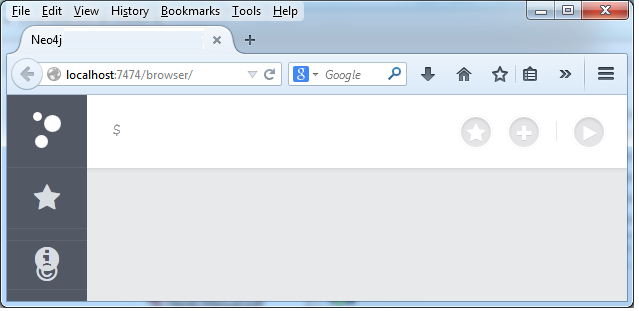
Step 2 - Type the below command at dollar prompt in Data Browser.
MATCH (cc:CreditCard) RETURN cc
Click on "Download CSV" to see the results

DebitCard Node data
Step 1 - Open Neo4j Data Browser
Step 2 - Type the below command at dollar prompt in Data Browser.
MATCH (dc:DebitCard) RETURN dc
Click on "Download CSV" to see the results

We will use this data to explain the usage of Neo4j CQL UNION with examples
Example
This Example demonstrates what will happen if both queries of UNION clause does have same names or same data types to their columns.
Step 1 - Open Neo4j Data Browser
Step 2 - Type the below command at dollar prompt in Data Browser.
MATCH (cc:CreditCard) RETURN cc.id,cc.number UNION MATCH (dc:DebitCard) RETURN dc.id,dc.number
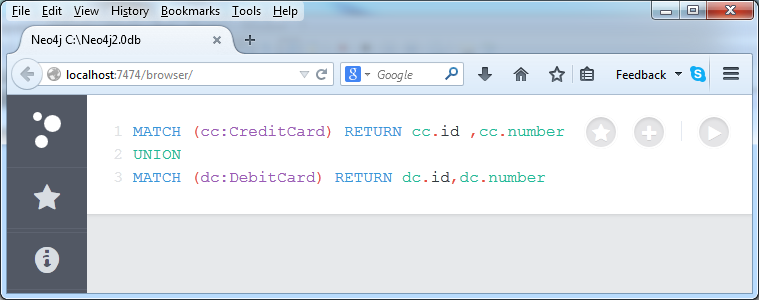
Step 3 - Click on Execute button and see the success message in the Data Browser.
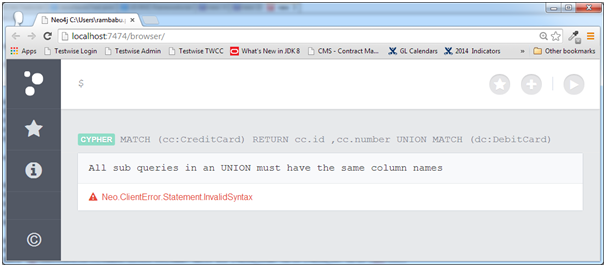
It shows that both queries should have same column names.
First query has : cc.id,cc.number.
Second query has : dc.id,dc.number.
Here both CreditCard and DebitCard has same property names : id and number, but they have prefixed with different node names. That's why UNION command is showing this error message. To avoid this error, Neo4j CQL has provided "AS" clause.
Like CQL, Neo4j CQL "AS" clause is used to give some alias name.
Example
This Example demonstrates How to use UNION clause to retrieve data from two nodes.
Step 1 - Open Neo4j Data Browser
Step 2 - Type the below command at dollar prompt in Data Browser and Click on Execute button.
MATCH (cc:CreditCard) RETURN cc.id as id,cc.number as number,cc.name as name, cc.valid_from as valid_from,cc.valid_to as valid_to UNION MATCH (dc:DebitCard) RETURN dc.id as id,dc.number as number,dc.name as name, dc.valid_from as valid_from,dc.valid_to as valid_to
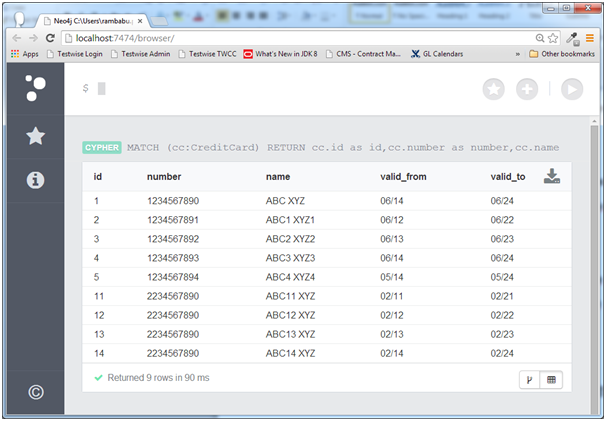
Here we can observe this command returns 9 rows without duplicate rows because UNION clause filters them.
UNION ALL Clause
It combines and returns all rows from two set of results into a single set of results. It returns duplicate rows also from two nodes.
Restriction
Result column types and names from two set of results have to match that means column names should be same and column's data types should be same.
UNION ALL Clause syntax
<MATCH Command1> UNION ALL <MATCH Command2>
Syntax Description
| S.No. | Syntax Element | Description |
|---|---|---|
| 1. | <MATCH Command1> | It is CQL MATCH command one to be used by UNION clause. |
| 2. | <MATCH Command2> | It is CQL MATCH command two to be used by UNION clause. |
| 3. | UNION ALL | It is a Neo4j CQL keyword for UNION ALL clause. |
Note -
If both queries does not return same column names and data types, then it throws an error.
In this chapter, we will take a Banking application nodes : CreditCard and DebitCard to explain UNION clause
CreditCard Node data
Step 1 - Open Neo4j Data Browser
Step 2 - Type the below command at dollar prompt in Data Browser.
MATCH (cc:CreditCard) RETURN cc
Click on "Download CSV" to see the results

DebitCard Node data
Step 1 - Open Neo4j Data Browser
Step 2 - Type the below command at dollar prompt in Data Browser.
MATCH (dc:DebitCard) RETURN dc
Click on "Download CSV" to see the results

We will use this data to explain the usage of Neo4j CQL UNION with examples
Example
This Example demonstrates what will happen if both queries of UNION clause does have same names or same data types to their columns.
Step 1 - Open Neo4j Data Browser

It is Neo4j Data Browser Homepage
Step 2 - Type the below command at dollar prompt in Data Browser.
MATCH (cc:CreditCard) RETURN cc.id as id,cc.number as number,cc.name as name, cc.valid_from as valid_from,cc.valid_to as valid_to UNION ALL MATCH (dc:DebitCard) RETURN dc.id as id,dc.number as number,dc.name as name, dc.valid_from as valid_from,dc.valid_to as valid_to
Step 3 - Click on Execute button and see the success message in the Data Browser.
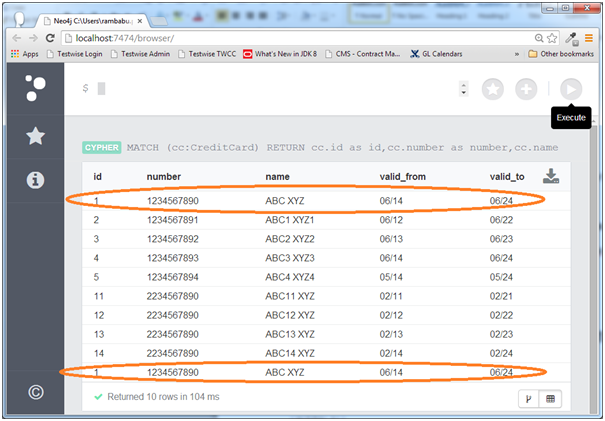
Here we can observe this command returns 10 rows with duplicate rows because UNION ALL clause does not filter them. If we use UNION clause, it returns only 9 rows. Please refer UNION clause chapter to check this.